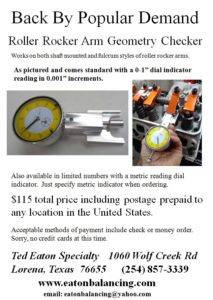Just click on the topic you’d like to view.
Altering Rocker Arm Ratio by Varying the Pushrod Length
Camshaft and Lifter Failure Causes
Cylinder Head Milling For A 1cc Reduction
Degreeing in the camshaft – Part I – Finding TDC
Degreeing in the camshaft – Part II – Phasing in the cam
Degreeing in the camshaft – Part III – Rollmaster timing chain for the Y
Head Gasket Volume Calculations
Milling heads for a horsepower gain
Oil Viscosity and Its Effect on Engine Power
Modifying the Holley Model 4000 (Teapot) for late model distributors
Modifying the Holley 94 two barrel carb for late model distributors
Ford Y-Block – 2X4 Intake Manifold Testing on Iron Heads
Ford Y-Block – 2X4 Intake Manifold Testing on Aluminum Heads
Ford Y-Block – 3X2 Intake Manifold Testing
Ford Y-Block Offenhauser 3X2 Testing by Joe Craine
Ford Y-Block – Aluminum Head Testing Part I
Ford Y-Block – Aluminum Head Testing Part II
Ford Y-Block – Cylinder Head Testing Part 1
Ford Y-Block – Cylinder Head Testing Part 2
Ford Y-Block – Exhaust Testing
Ford Y-Block – Hopping Up The 272
Ford Y-Block – New Life for a 1955 P Code 292 Police Engine
Ford Y-Block – 585HP without a supercharger or other power adder
Ford Y-Block – 318 inch buildup using aluminum heads
Ford Y-Block – 330 inchers, aluminum head and iron head versions are both dyno tested.
Ford Y-Block – Stock Iron Heads Can Still Make a HP to the Cubic Inch
Ford Y-Block – Stock or Modified? Here Are Two Different Builds
Ford Y-Block – Four Barrel Carburetor Testing Using the Iron ECZ-B Intake
Ford Y-Block – Hi Volume Oil Pump For The Y
Ford Y-Block – Neoprene Rear Main Seal Installation (also works for others)
Ford Y-Block – Top End Oiling Woes
Ford Y-Block – Warped Rear Seal Retainer
Ford Y-Block – 292/312 Rear Cam Plug Installation
Building The Foundation for an Eight Second Ford Y
Blueprinting For An Eight Second Ford Y-Block
A 500 HP+ Ford Y-Block at the 2010 Engine Masters Challenge
Preparing a 375 inch Y-Block for the 2009 Engine Masters Challenge
A Ford Y-Block at the 2009 Engine Masters Challenge – Summary
Engine Masters Challenge Ford Y-Block Entry for 2007
The Ford Y-Block Engine – History and cubic inch particulars

